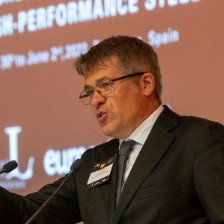Hot Sheet Metal Forming of High Performance Materials
A special issue of Metals (ISSN 2075-4701). This special issue belongs to the section "Metal Casting, Forming and Heat Treatment".
Deadline for manuscript submissions: closed (30 September 2023) | Viewed by 6815
Special Issue Editors
Interests: thermo-mechanical materials processing; simulation methods; modelling of fracture and fatigue; simulation of thermo-mechanical process chains including predictions of product performance
Interests: high temperature tribology; friction and wear in dry contacts; tribomaterials; surface engineering for friction and wear control
Special Issues, Collections and Topics in MDPI journals
2. Division of Mechanics of Solid Materials, Luleå University of Technology, Luleå, Sweden
Interests: fracture mechanics; fatigue; advanced high strength steels
Special Issues, Collections and Topics in MDPI journals
Special Issue Information
Dear Colleagues,
The biannual CHS2 conference series has, after seven very successful conferences since 2008, grown into the leading platform for scientific exchange in hot forming technologies.
The interest in thermo-mechanical forming processes of high-performance materials has grown significantly in recent years. The automotive sector has been the main actor driving this development, pushed by the constant demands on passenger safety and environmental regulations. Press hardening of boron steels is now a mature technology, deployed all around the world. It has proven to be unbeatable for forming complex shape parts and easy forming of high strength materials with reduced spring-back. It also allows for producing parts with tailored properties under accurate process monitoring. These benefits offer great flexibility and open up possibilities to implement new materials in new industrial applications.
Research and Development both on the academic as well as on the industrial level is one of the most important prerequisites for continuous innovation in hot forming of high performance materials and open new scenarios to exploit their lightweight potential. The 8th CHS2 conference will be held in Barcelona (Spain) and aims to keep pushing the innovation trends in press hardening and related thermo-mechanical processes and to boost their application to other markets (such as heavy duty and industrial vehicles, aerospace, etc.), new applications (new needs from e-mobility) and new materials (stainless steels, light alloys, CFRP, hybrid materials, etc.).
Prof. Dr. Mats Oldenburg
Dr. Jens Hardell
Prof. Dr. Daniel Casellas
Guest Editors
Manuscript Submission Information
Manuscripts should be submitted online at www.mdpi.com by registering and logging in to this website. Once you are registered, click here to go to the submission form. Manuscripts can be submitted until the deadline. All submissions that pass pre-check are peer-reviewed. Accepted papers will be published continuously in the journal (as soon as accepted) and will be listed together on the special issue website. Research articles, review articles as well as short communications are invited. For planned papers, a title and short abstract (about 100 words) can be sent to the Editorial Office for announcement on this website.
Submitted manuscripts should not have been published previously, nor be under consideration for publication elsewhere (except conference proceedings papers). All manuscripts are thoroughly refereed through a single-blind peer-review process. A guide for authors and other relevant information for submission of manuscripts is available on the Instructions for Authors page. Metals is an international peer-reviewed open access monthly journal published by MDPI.
Please visit the Instructions for Authors page before submitting a manuscript. The Article Processing Charge (APC) for publication in this open access journal is 2600 CHF (Swiss Francs). Submitted papers should be well formatted and use good English. Authors may use MDPI's English editing service prior to publication or during author revisions.
Keywords
- press hardening
- hot forming
- process modelling
- microstructure
- surface engineering and coatings
- process monitoring
- fatigue and fracture
- friction and wear






